Mastering the Art of Creating a Stunning Gallery Wall


Intro
Creating a gallery wall can bring a breath of fresh air to any interior space. It's not just about haphazardly slapping some pictures on the wall. No, a well-designed gallery wall represents a unique visual narrative that can unite a room. Whether you're a novice interior designer or a seasoned decorator, the process involves careful consideration of layout, artwork selection, and practical hanging techniques. But don’t worry, we are here to walk you through it step-by-step.
While some might think that a gallery wall is merely an aesthetic venture, it also serves as a reflection of personal taste and style. An artful display of photos, paintings, and other creations can tell a story — one that's rooted in memories, experiences, or simply an appreciation for beauty. The key is to strike the right balance between cohesion and variety.
From large, bold pieces that demand attention to smaller, curated works that invite exploration, a gallery wall offers a platform where personal and artistic flair meet. By the end of this guide, you will have all the tools necessary to create a stunning gallery wall that not only enhances your environment but also speaks volumes about who you are.
Understanding the Concept of a Gallery Wall
Creating a gallery wall in your home isn’t just about haphazardly throwing up some pictures. It’s a thoughtful endeavor that combines art, design, and personal expression. Understanding this concept is essential for anyone looking to enhance their space. A gallery wall serves as a focal point, drawing the attention of guests and creating a dialogue within the room. Its importance lies not only in how it beautifies a space but also in how it reflects the individual’s tastes and experiences.
Definition and Purpose
A gallery wall is essentially a curated collection of art pieces, photographs, or other decorative items, arranged in a harmonious way on a single wall. The primary purpose is to showcase your personality and style. This form of display breaks the monotony of blank walls, offering a canvas for creativity. By mixing genres, framing styles, and even incorporating three-dimensional elements, individuals can create a narrative or theme that resonates with them.
For many, the gallery wall acts as a visual diary. Each piece tells a story, whether it’s a trip to a remote destination, a cherished family memory, or simply art that speaks to one’s soul. This personalization invites visitors into the homeowner’s world, making it a special aspect of interior design.
Key Benefits of a Gallery Wall:
- Artistic Expression: It’s a chance to display what you love.
- Dynamic Aesthetic: Various artworks can create visual interest and depth to a room.
- Easy to Update: You can refresh the wall by swapping pieces seasonally or as your style evolves.
- Conversation Starter: Guests often enjoy commenting on art that they connect with or find intriguing.
Historical Context
The concept of the gallery wall is not a modern fad; it has roots that trace back to art exhibitions and salons of the past. In the 18th and 19th centuries, affluent individuals often created immersive environments within their homes by displaying significant artworks collected from their travels. These collections provided a glimpse into their social status and cultural awareness.
Flash forward to modern times, and the gallery wall has evolved. Homeowners have taken inspiration from art galleries, museums, and even social media, where images of gallery walls saturate platforms like Pinterest and Instagram. This evolution reflects broader trends in society, where individuality and self-expression are more emphasized than ever. The era of minimalism is shifting, making way for bold displays that highlight one's personality rather than conforming to decor norms.
Assessing Your Space
Before embarking on the journey of curating a gallery wall, it’s crucial to take a step back and assess your space. This is not just about physical measurements; it encompasses understanding the vibe of the room, how light interacts with your proposed arrangements, and how your collection of art will resonate within that context. Getting right into this phase means setting yourself up for success, minimizing any headaches down the line. This step is about taking note of the walls that speak to you, as well as considering how they serve the function of the room.
Identifying Wall Space
Your walls are blank canvases, just waiting to be transformed into a curated display of your personality and interests. To start, you need to identify the right wall space for your gallery. Look for walls that draw the eye naturally. Some folks prefer a long, uninterrupted wall as it allows for an expansive display, while others find charm in smaller walls or nooks.
Here are some aspects to consider when identifying wall space:
- Visibility: Choose a wall that will be seen often, whether it’s in the living room, hallway, or even a home office. This guarantees that your art collection will be part of daily life.
- Proximity: Walls close to seating areas can invite viewers to appreciate details up-close. Tightly arranged art pieces provide an intimate viewing experience.
- Condition: Ensure the wall is in good condition, free from dampness or peeling paint. Trust me, a splash of fresh paint can work wonders and set a perfect backdrop.
Considerations for Room Functionality
The intended functionality of the room can significantly shape your gallery wall concept. The atmosphere of space often guides not only what to display but also how to display it. For instance, consider these factors:
- Room Purpose: In a tranquil bedroom, gentle colors and soothing landscapes might be appropriate, while a lively home office could benefit from energizing abstracts or motivational quotes.
- Flow of Movement: Explore how people navigate through the room. Avoid placing pieces where they may get inadvertently knocked or blocked by furniture. This setup ensures your art remains the focal point, not an afterthought.
- Natural Light: An abundance of natural light can enhance the visual impact of your art but be wary of direct sunlight, which could fade certain materials over time.
Your wall's unique personality will dictate the tone and ambiance of your gallery. Each decision made during this phase is laying a foundation that your art will build upon, so take the time to analyze thoughtfully.
"A well-thought-out wall can bridge the gap between mere decoration and an expression of identity."
Identifying perfect wall space and understanding functionality allows you to optimize your gallery wall design to suit not just the art itself, but the home environment altogether. Embrace the space, and the outcome will reflect both you and your artistry.
Selecting Artworks
Choosing the right artworks is arguably the soul of your gallery wall. Not only do they serve as a reflection of your artistic tastes and personal narrative, they also set the tone for the entire space. Selecting pieces that resonate with you can turn an ordinary wall into a visual story. There are several elements to weigh when choosing artworks, such as emotional impact, aesthetic diversity, and personal relevance.
Types of Art to Consider
Original Paintings
When we think about unique expression, original paintings really stand out. These pieces are typically one-of-a-kind, giving your gallery wall a touch of uniqueness that mass-produced art simply can’t. Paintings allow for various styles, from abstract to realism, each capable of evoking different emotions.
The key characteristic of original paintings is their ability to connect deeply with the viewer. This connection often makes such artworks a favorite among collectors and enthusiasts. Furthermore, the brushstrokes and texture of paintings introduce a tactile quality, which adds depth to your wall display.
However, original paintings can be on the pricey side, especially if you’re purchasing from established artists. It requires careful consideration and sometimes, a fair bit of saving. But the investment might just pay off, as an original piece could appreciate in value over time.
Prints and Photographs
On the other hand, prints and photographs provide accessibility without compromising on style. These pieces are often more affordable, which makes them ideal for anyone looking to create a gallery wall without breaking the bank.
The hallmark of prints and photographs is repetition. With technically produced pieces, you can easily scale your collection by purchasing various prints of the same theme or even different sizes in tandem. Additionally, they can capture and immortalize fleeting moments, particularly in photography, telling stories through imagery.
Yet, while prints and photographs can be widespread, limiting yourself to low-quality reproductions can diminish the impact of your gallery wall. It’s best to source them from reputable sellers or artists who respect their craft.
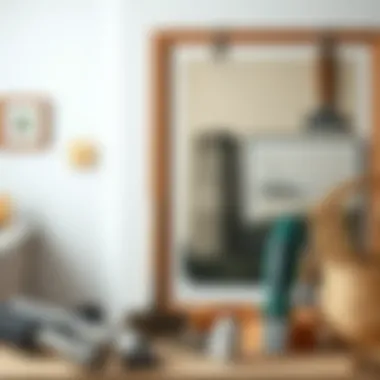
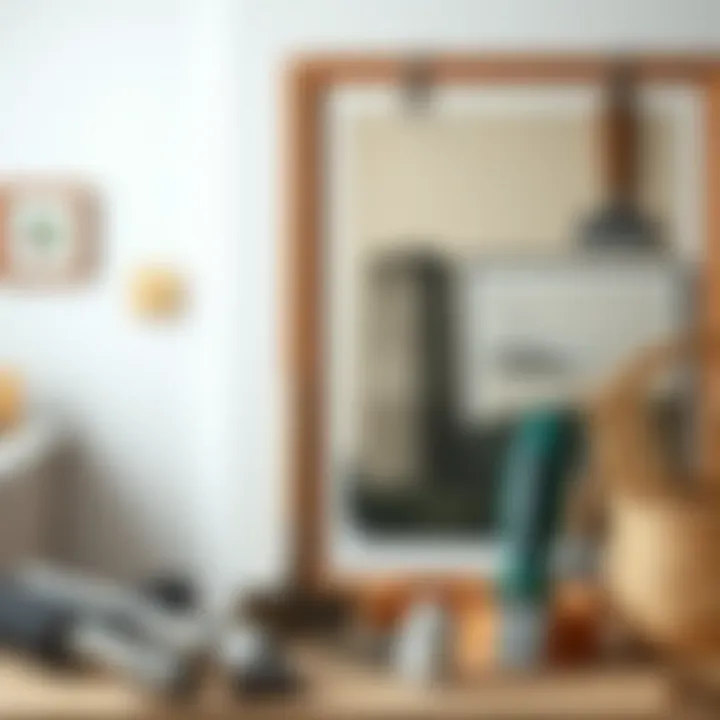
Mixed Media
Now, let’s dive into mixed media. This art form combines different materials and techniques, creating dynamic and eye-catching designs. Mixed media allows for great flexibility, merging collage, painting, and even found objects, to compile an artwork that resonates with numerous styles.
One of the main advantages is the ability to create depth and interest by layering textures. This diversity encourages creativity, allowing you to showcase more than just visual art—perhaps even integrating elements of sculpture or textiles.
However, mixed media pieces can be quite intricate. They may require more consideration in terms of framing and display to ensure that each layer stands out rather than causing visual clutter on your wall.
Curating a Personal Collection
Curating a personal collection of artworks is akin to piecing together your life story. Rather than just haphazardly slapping up art, it’s crucial to develop a vision for your gallery wall. Think about themes or motifs that speak to your journey or aesthetics that evoke the right emotions within your space.
Start by collecting pieces that resonate with you. They could range from a childhood watercolor to a contemporary piece you stumbled upon while traveling. Consider how each piece can relate to others—synergy matters. As you gather your collection, reflect on balance, not just in terms of size, but also color and style. This balance will weave a harmonious narrative that will command attention.
"Your wall isn’t just decoration; it’s a window into your world, a gallery that showcases not just art but your personal journey."
Taking the time to select and arrange each artwork thoughtfully can take your space from mundane to marvelous.
Layout Planning
Layout planning is where the magic of your gallery wall comes to life. This stage transitions your ideas from a mere concept to a physical arrangement that speaks volumes about your taste and personality. When thinking about layout, consider the context of your living space as well as the emotional response you want to evoke. A well-planned gallery wall doesn’t just showcase art; it creates a visual narrative that weaves through your home, underlining your individual flair and boosting the room’s overall aesthetic appeal.
The choices of arrangement patterns greatly influence the effectiveness of the display. Opting for a thoughtful layout can make a small collection look as if it has depth or turn an eclectic array into a harmonious ensemble. One prominent method of layout planning is deciding between grid arrangements or more organic salon styles, each with its own advantages and unique charm.
Grid vs. Salon Style
The grid layout is the epitome of clean lines and uniformity. It involves aligning art pieces in a structured way, often with equal spacing between them, which yields a sense of order. This arrangement works especially well in spaces where minimalism is favored, such as modern apartments or offices. Its predictability can be comforting to the eye, presenting art as an organized collection.
On the other hand, the salon style lets creativity run wild. Mixing different shapes, sizes, and textures reflects a more casual, lived-in feeling. Think of it like an impromptu gallery showcasing your collection without the constraints of perfection. Although salon style usually embraces chaos, it requires a careful approach to avoid overwhelming the viewer.
Creating a Visual Flow
Creating a visual flow is essential, as it guides the viewer’s gaze through your gallery wall, enhancing the experience of viewing your art. The goal is to ensure continuity between the different pieces, making the wall not just a display of individual items, but rather a cohesive story. Two critical factors in establishing this flow are balancing sizes and shapes, along with color coordination.
Balancing Sizes and Shapes
Balancing sizes and shapes is about achieving equilibrium in your artwork layout. If you have a large piece, pair it with smaller works that can support its presence without competing. This isn't merely an aesthetic choice; it creates a sense of stability on your wall.
A key characteristic of this method is the way it highlights depth and dimension—large pieces draw the eye first, but the smaller ones fill in the gaps, leading to a more fulfilling visual journey. This strategy is benefecial for those with a variety of art, as it allows diverse pieces to shine without overshadowing one another. However, the unique challenge lies in ensuring that the sizes don't clash; too much disparity could lead to visual discord.
Color Coordination
Color coordination breathes life into your gallery wall, making it a dynamic element of your decor. By thoughtfully choosing a color palette that ties your artwork together, you can create a sense of harmony within the diversity. This method ensures that your gallery isn’t just an assortment of art but rather a unified artwork itself.
A prominent aspect of color coordination is its ability to evoke certain feelings. Warm tones can create a cozy atmosphere, while cooler palettes might lend a more tranquil vibe. This degree of intentionality makes it a popular choice among interior enthusiasts who want their spaces to be not only stunning but also expressive. Yet, one must tread carefully. Too much emphasis on matching colors can stifle the individuality of each piece, so finding the right balance is crucial.
"A gallery wall reflects who you are. It's not just about art, but about creating an experience that resonates with your own journey."
Measuring for Precision
Creating a gallery wall isn’t just about slapping some images on the wall and calling it a day. Precision in measurement is key to achieving a cohesive look that resonates with the eye. When you measure correctly, you ensure that your artworks are well spaced, properly aligned, and overall aesthetically pleasing. This process not only enhances the visual appeal but also shows an attention to detail that reflects your personal style.
Before setting your art pieces in place, it is crucial to understand the tools needed and how to establish the appropriate measurements.
Tools Required
To get started, you’ll need some specific tools that will make this task a whole lot easier. Here’s a quick list:
- Measuring tape: Essential for getting that precise length.
- Pencil: For making light marks on the wall that can be wiped away.
- Level: To ensure your frames are straight; nothing looks worse than crooked art.
- Hammer or drill: Depending on the hardware you're using to hang your art.
- Stud finder: Especially helpful if you're hanging heavier pieces to locate wall studs.
These tools combined will lay the groundwork for successful wall mounting. Without them, you may find yourself guessing, and that’s a no-go in the world of design.
Establishing Measurements
Once you've gathered your tools, it's time to delve into establishing your measurements which is crucial for hanging a gallery wall effectively.
Height Considerations
When it comes to height, general wisdom suggests that the center of your art should be hung at eye level, around 57 to 60 inches from the ground. This choice is beneficial because it provides a comfortable viewing angle for most people, making your gallery feel accessible.
Having a consistent height helps to establish a uniform look across your gallery, preventing a visual hiccup. If you're dealing with varied heights throughout your space, consider using a measuring stick or knotted string to ensure everything aligns harmoniously. One downside? If your artwork is too high or too low, it could lead to a disjointed viewing experience, leaving onlookers scratching their heads.
Spacing Between Art Pieces
Next up is figuring out how much space to leave between each piece. A common rule of thumb is to aim for 2 to 5 inches between the edges of the frames. This spacing allows each artwork to breathe while still feeling connected as part of a singular expression.
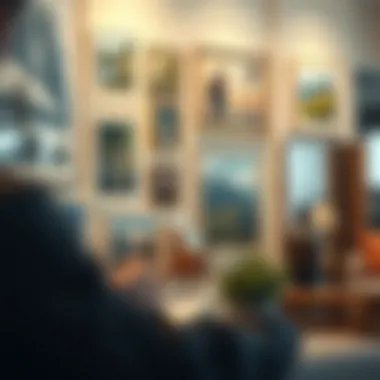

The beauty of this measure is that it gives viewers enough room to appreciate the details in each piece without overwhelming their senses. However, spacing can also be subjective, as some may prefer a tighter salon-style arrangement or a wider, more airy approach. Keeping in mind the scale and size of your artworks will further guide you—this ensures that your gallery wall maintains harmony rather than chaos.
Effective measurement techniques make all the difference in curating a gallery wall that not only reflects personal style but invites observation and admiration.
Hanging Techniques
When it comes to forming a gallery wall, hanging your artworks is arguably the most crucial part of the entire process. It's not merely about arranging a few prints or photographs; it's about how they are displayed that can either make or break the aesthetic appeal of your space. A well-hung gallery wall draws the eye, creates harmony, and showcases your personality. Conversely, poor techniques can lead to a chaotic or uninviting atmosphere. Thus, understanding the right hanging techniques is a pivotal step for anyone looking to transform their walls into a stunning display.
Choosing the Right Hardware
Getting the hang of it starts with the right hardware. Using adequate tools tailored for your walls and artworks ensures a sturdy and secure display. Hardware options vary:
- Nails or Picture Hooks: Suitable for lightweight pieces, these are straightforward and relatively easy to use.
- Wall Anchors: For heavier pieces, especially those with frames made from thicker materials, wall anchors provide extra support, preventing anything from crashing down.
- Command Strips: Perfect for renting environments, these strips offer a no-damage solution. They can hold quite a bit of weight without leaving a mark, making them ideal for those hesitant to put holes in their walls.
Selecting the right hardware is paramount not only for aesthetics but for safety considerations as well. A hanging frame that drops can lead to damaged art or even personal injury. Adjust your choices based on what you're hanging and the type of wall you have, whether it's drywall, plaster, or brick.
Step-by-Step Hanging Process
Now let’s get down to the nitty-gritty. If you’re set to hang your gallery wall, follow this methodical step-by-step approach:
- Planning Your Arrangement: Before any nails go in, lay your framed artworks on the floor to visualize their placement. Consider patterns, color palettes, and sizes.
- Marking The Wall: Once satisfied with your arrangement, use a pencil to lightly mark where each piece will go. A measuring tape ensures everything is spaced evenly.
- Preparing the Hardware: For heavier pieces, it’s time to install your wall anchors at the marked spots. For lighter pieces, mark where the hooks will go directly on the wall.
- Hanging The Art: Securely fasten your hardware and hang each piece, checking that they are level. A small level tool can make this task easier, ensuring that each artwork hangs straight.
- Final Adjustments: Step back and assess the entire wall. Adjust as necessary to ensure a cohesive look and feel across the display.
By adhering to these steps, you avoid common pitfalls, like crooked frames or uneven spacing, which can detract from the overall appeal. Here’s a reminder:
"Measure twice, hang once" - a phrase that emphasizes precision in your hanging technique.
Incorporating the right hardware, coupled with a methodical approach in the hanging process, transforms the often daunting task of curating a gallery wall into an enjoyable and satisfying experience.
Incorporating Lighting
When creating a gallery wall, the role of lighting cannot be overstated. It serves not only to highlight your selected artworks, but also to create an atmosphere that resonates with the mood you want to convey. Good lighting can enhance colors, emphasize textures, and even create shadows that add depth, drawing viewers into your visual narrative. By carefully planning your lighting, you can turn a simple display of art into an immersive experience.
Natural vs. Artificial Light
Understanding the balance between natural and artificial light is crucial when designing your gallery wall. Natural light, coming from your windows, can change dramatically throughout the day. Morning light might bathe your artworks in a soft glow, while afternoon sun can create harsh shadows and fade colors over time. Here are a few things to consider:
- Window Placement: Observe how light spills into your room at different times of day. Hanging art where it gets a gentle caress of sunlight is often preferable.
- Avoid Glare: When your space is flooded with light, it can create glare on glass-covered pieces. Consider the angle and placement of your wall to avoid this.
On the flip side, artificial light can be tailored to suit your needs:
- Types of Bulbs: The spectrum of the light bulb affects how colors appear. Warm white bulbs tend to complement warmer artworks, while cool white can enhance more modern, vibrant pieces.
- Control: With dimmers or varied placement, you can direct light exactly where it needs to go, thus adjusting your gallery wall's ambiance depending on the occasion.
Spotlighting Techniques
Spotlighting can add a dramatic flair to your gallery wall. These techniques help focus attention and can create theatrical lighting effects that draw the eye to specific pieces. Here’s how:
- Directional Lighting: Installing adjustable light fixtures allows you to direct beams precisely onto each artwork. This creates a spotlight effect that can bring emphasis to a significant piece.
- Track Lighting: Running a track along the ceiling provides a way to install multiple fixtures. You can rearrange the lights as desired when you rotate or switch out art on your wall.
- Picture Lights: These are specifically designed for illuminating framed art. They can be mounted directly above the artwork or attached to the wall. This not only enhances visibility but also adds elegance to the display.
Maintaining the right aspects of lighting creates an inviting and engaging gallery wall. The interplay of lights, both natural and artificial, can define the aura of your gallery, guiding the viewer's emotions and thoughts as they navigate through your art collection. For in-depth tips on lighting, check out resources from Wikipedia or Britannica.
"Good lighting can transform a room as much as the decor itself."
Incorporating thoughtful lighting into your gallery wall shows a higher level of attention to detail, enhancing the overall presentation of your curated art collection.
Maintaining Your Gallery Wall
Maintaining a gallery wall is more than just a one-time setup; it requires an ongoing commitment to ensure that the collection remains dynamic and visually appealing. Like any art form, a gallery wall evolves over time, reflecting changing tastes, seasonal themes, or even the moods of its creators. Ignoring this aspect can lead to a stale or cluttered look that detracts from the overall aesthetic of your space.
Regular attention to your gallery wall offers a multitude of benefits. For one, it can keep the artworks looking their best, ensuring that they do not fade, degrade, or become damaged over time. Moreover, it presents an opportunity to refresh the space without the need for any major renovations or purchases. Maintaining a gallery wall also allows for a personal touch, as it can evolve with your life and experiences, making your home feel more alive.
Regular Updates and Rotations
One effective strategy for maintaining your gallery wall is to establish a routine for regular updates and rotations. This doesn’t necessarily mean you must swap out every piece, but consider rearranging the layout or introducing new artwork every so often. For instance, seasonal decorations could breathe life into your gallery — a few vibrant autumn prints in October, followed by wintry landscapes in December. This rotational approach can keep your space feeling fresh and inviting.
Here are some tips to help with regular updates:
- Rotate Art Monthly: Change one or two pieces each month. This keeps the wall lively without overwhelming your display.
- Seasonal Themes: Use different themes for each season or holiday. This not only enhances your gallery wall but also your overall decor.
- Guest Displays: If you have friends or family who create art, consider displaying their work for a period. It adds a personal touch and promotes community.
“A gallery wall is like a diary for your living space; it tells stories through every piece.”
Caring for Your Artworks
Caring for the artworks on your gallery wall is of utmost importance. Neglecting the maintenance of these pieces could lead to irreversible damage. Different art types require different care, so understanding how to protect each piece can be invaluable. For example, original paintings made with oil paint may need to be checked regularly for heavy dust or the development of cracks.
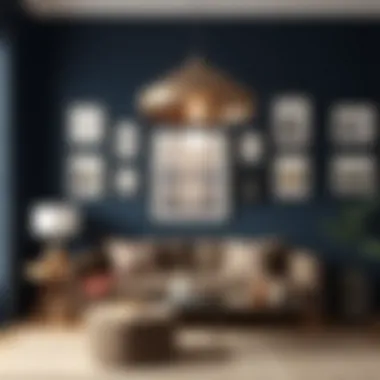
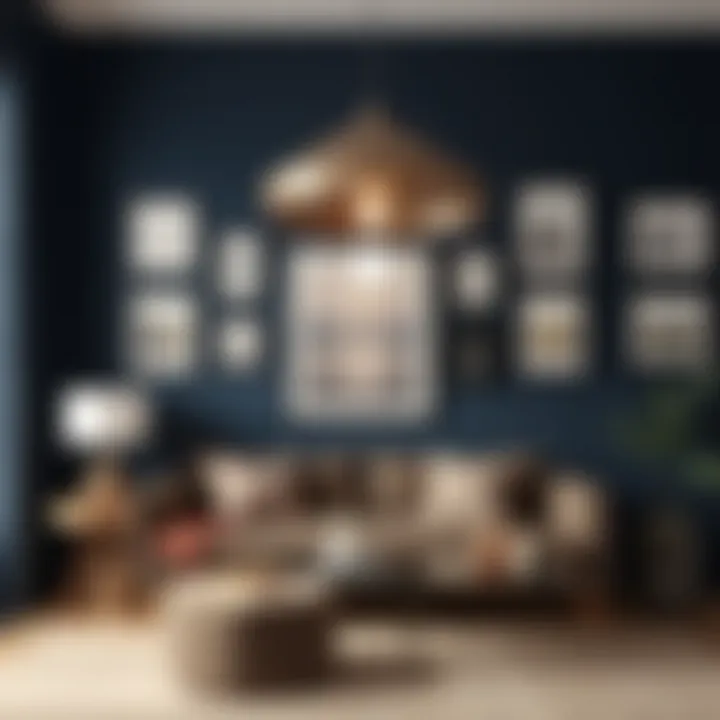
Here are some considerations for the care of your artworks:
- Dust Regularly: Light dusting can prevent grime from accumulating. Use a soft cloth or a feather duster, avoiding any harsh cleaning products.
- Control Environment: Too much sunlight can fade colors; consider using UV-filtering glass for frames. Also, maintain stable humidity levels to protect art from warping or cracking.
- Inspect for Damage: Periodically check frames, glass, and the integrity of the art itself. If you spot damage, addressing it swiftly can save the piece.
Maintaining a gallery wall can be seen as an art form in itself, fostering a personal connection with each piece while enhancing the atmosphere of your home. Balancing updates, rotations, and care can truly create a living reflection of your personality and experiences.
Common Challenges and Solutions
Creating a gallery wall can sometimes feel like a walk in the park, but it often transforms into a tricky balancing act. This section dives into some of the common pitfalls many encounter and provides clear solutions to handle those bumps along the way. Understanding these challenges not only smoothens the process, but also boosts your confidence in artsy endeavors. By being aware of potential hiccups, you can transform what seems messy into a masterpiece of personal expression.
Addressing Uneven Walls
One of the significant challenges that homeowners face when setting up a gallery wall is the nature of the wall itself. Not all walls are painted evenly or squared off neatly, and some houses, especially older ones, might have a slight tilt or curve that you wouldn’t spot without a keen eye. This is where preparation can make or break your design.
- Evaluate the Wall Surface: Before hanging art, stand back and assess the wall. Use a level to see where it might dip or rise unexpectedly. A straight line isn’t just about aesthetics; it affects how your gallery will look as a whole.
- Choose the Right Hanging Method: If your wall isn’t flawless, consider using a gallery ledge instead. This lets you adjust pieces easily without committing to drilling holes into your wall. In cases where you're still dedicated to directly hanging the art, using templates can help you visualize where pieces would go, allowing for adjustments on the fly.
"Remember, it's better to take your time and measure than to rush and end up regretting it later."
Seeking tools like wall adhesive strips can also help create an illusion of a straight gallery without needing to slaughter the walls with nails or hooks. This can be especially useful in rental spaces where wall damage needs to be minimized.
Correcting Mistakes
Even the best plans can go awry, and sometimes things just don’t click as expected after hanging. Perhaps the art is too high, or the spacing feels cramped. Fortunately, most mistakes are correctable with just a bit of thought and effort.
- Don't Hesitate to Adjust: It’s totally acceptable, even encouraged, to adjust your pieces until they fit just right. If you feel something isn’t lined up properly, don’t shy away from tapping a nail here or moving a piece there. A gentle nudge can make a world of difference.
- Transform Mistakes into Opportunities: If you’ve made a misstep with spacing or alignment, think creatively. Can you add in an extra piece to balance things out? Or perhaps, a larger piece could act as a statement item that draws the eye and distracts from earlier errors?
- Document the Process: Take a picture of your wall from multiple angles after hanging. This way, you can look back and understand what adjustments might be necessary, and see how far you’ve come along in the process.
By tackling the above challenges proactively, you turn a potential shopping list of worries into a collection of unique solutions. With a pinch of patience and the eagerness to adapt, your gallery wall will become a true representation of your style and taste, seamlessly blending into your space.
Gallery Wall Trends and Inspirations
Creating a gallery wall is more than just hammering a few nails into your drywall; it’s about telling a story through your chosen pieces. The trends in gallery walls are ever-changing, just like our tastes in art and décor. Therefore, diving into contemporary trends and drawing inspiration from notable examples can spark creativity and ensure the final display feels cohesive and fresh.
Current Design Trends
Today’s gallery walls are not just about hanging art; they’re a holistic design choice reflecting lifestyle and personality. Here are some key design trends to consider:
- Eclectic Mix of Materials: Instead of sticking to just framed artwork, contemporary gallery walls can incorporate mirrors, textiles, and even objects like shadow boxes or clocks. This approach creates depth and a layered feel, making the wall come alive.
- Lounge-Like Atmosphere: Incorporating art into living spaces should promote comfort. Nowadays, galleries extend beyond brushed frames. People are using art to create cozy vignettes that mix art with other decorative elements like plants or lighting fixtures.
- Bold Colors and Textures: Moving away from neutral tones, many trendsetters boldly choose vibrant colors enhancing the artwork’s appeal. Textured backgrounds, like wallpaper or wood paneling, work wonders in making elements of the gallery pop.
- Theme-Based Collections: Curating collections around specific themes such as travels, family history, or favorite memories creates more significance. Such a focus allows viewers to connect with the exhibited works on a personal level.
Imagining a gallery wall based on these trends invites exploration and experimentation. It offers flexibility in how each element resonates to you and your space, ensuring your gallery wall is as unique as your personal tastes.
Case Studies of Notable Gallery Walls
Residential Spaces
In residential spaces, the gallery wall acts as both a decorative element and a conversation starter. Many homeowners have nuanced stories tied to the art they select, from family portraits to pieces from local artists that resonate with their experiences.
A key characteristic of residential gallery walls is their ability to evolve. As families grow and experiences change, the walls can be updated to reflect new milestones and memories, keeping the display dynamic.
For example, a family may start with children’s artwork displayed in frames that grow alongside their artistic talents. This ongoing transformation is a major draw for choosing this style; it allows the gallery wall to mirror the family’s journey while also serving as decor.
However, one could argue the challenge lies in maintaining visual harmony. Too many pieces can clutter the space or confuse the eye. Therefore, it’s vital to balance the coordination of colors and frames for a pleasing effect.
Public Installations
Public installations take gallery walls to a grander scale, transforming whatever space they inhabit. They can express cultural narratives or highlight artistic innovation, making art accessible to broader audiences.
A distinctive aspect of public gallery walls is their emphasis on community engagement and interactive experiences. For instance, installations often invite viewer participation, blurring lines between artist and observer. This characteristic has made public displays popular, as they touch on social themes that resonate with collective experiences.
One example is the famous Wynwood Walls in Miami. This outdoor mural exhibit showcases large-scale artworks by diverse artists, contributing significantly to local culture and tourism.
However, there’s a risk with public installations; they may age rapidly. Weather and crowds can wear down in both physical condition and appeal. Proper maintenance and curatorial choices become crucial in sustaining such projects over time.
Ending
Creating a gallery wall is more than just hanging some art on a blank expanse; it’s an opportunity for personal expression and significant impact within a space. The art you select, the layout you choose, and the techniques employed to hang these pieces play pivotal roles in achieving a coherent and intentional display. By thoughtfully assessing your space and art, you engage in a process that not only beautifies your environment but also conveys your style and interests.
Summarizing Key Points
When summarizing the essential points discussed throughout this article, a few key takeaways emerge:
- Understanding your Space: It’s crucial to identify suitable wall spaces and consider the functionality of the room before starting your gallery wall project. The selection of space impacts how the artworks are perceived and enjoyed.
- Artwork Selection: Choosing the right pieces to feature is essential. Original paintings, prints, and mixed media can provide a range of style and texture. A personal collection curated over time or themed works can make your gallery wall not just attractive but also meaningful.
- Planning Your Layout: The decision between a grid or a salon-style layout affects the overall aesthetic. Balancing sizes, shapes, and colors creates visual interest and cohesion. Proper layout planning enhances the impact of your gallery wall.
- Hanging Techniques: Employ the correct hardware and tools for precision. The height at which art is hung and the spacing between pieces can drastically alter how they are perceived.
- Incorporating Lighting: Proper lighting can transform your gallery wall. Utilize both natural and artificial sources to highlight and enhance the artwork on display.
By keeping these elements in mind, you create not only a gallery wall but a narrative piece that reflects your essence.
Final Thoughts on Personal Expression
Gallery walls act as a canvas for self-expression, reflecting who you are and what you appreciate. This space can morph over time, adapting to new interests, travels, or experiences. Your choices in art type, arrangement, and the stories behind each piece breathe life into the space, making it truly yours.
Moreover, building a gallery wall can serve as a conversation starter, inviting friends and family to engage with your collection and share their interpretations. This creates an ongoing dialogue that enriches your home's ambiance.
Ultimately, this isn’t just about aesthetics; it’s about weaving a visual narrative that conveys your personal journey and sparks joy. So gather your pieces, and let your gallery wall tell your story.















